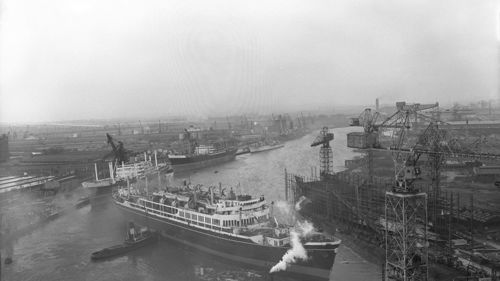SS Uganda - Times Past

In partnership with the Glasgow Times, our archivists are exploring Glasgow's fascinating history. This week, Nerys Tunnicliffe writes about the SS Uganda.
When we posted a photograph of the launch of the SS Uganda on our Facebook page, it proved to be extremely popular. Looking through the comments, it was clear that this ship was more than just a typical Clyde-built steamship and was part of many fond childhood memories.
Built and launched in Whiteinch in January 1952 by Barclay Curle and Company shipbuilders, the SS Uganda was intended to serve as a passenger and cargo liner for the British-India Steam Navigation Company (B&I). She could carry 167 first class and 133 tourist class passengers, along with 388,250 cubic feet of cargo and a crew of 287.
With two swimming pools, drawing and writing rooms, a large library and card room, passengers travelled very comfortably on the route to and from Britain and East Africa. There was nothing particularly unique about the SS Uganda’s design. However, her future would turn out to be far more varied than originally planned.
By the 1960s the increase in air travel led to a decline in demand for the slower ocean passenger liners such as the SS Uganda. The B&I decided that the best way for the company to survive would be to diversify their services, turning several of their ships into educational cruise ships.
The SS Uganda was the last of their ships to undergo this transformation, with an over two million pounds refit at Hamburg in 1967. The refit increased the passenger capacity to 1,226, providing classrooms, dormitories, a sports hall, music room and assembly hall with cinema.
Her new passenger pupils attended lessons by day or embarked on cultural tours when in port, later enjoying evening entertainments such as discos (overseen by the ship’s strict matrons!). By 1975, along with B&I’s other educational ship, SS Nevasa, the SS Uganda had accommodated hundreds of thousands of children to destinations all over Europe, mostly to Scandinavia and the Mediterranean. In the meantime, the Uganda’s ownership passed to P&O who had taken over B&I.
Whilst on another education cruise to Naples in 1982 with 940 school children and their teachers, the Uganda was to take on yet another role when she was requisitioned for duty in the Falklands War.
After depositing her passengers, Uganda had a quick refit, this time to install a helicopter platform, operating theatres, and wards transforming into a hospital ship. Painted white, with 8 red crosses, she carried 136 medical staff. Over 700 British and Argentine casualties were treated, and 504 operations took place, on board during her hospital service. After briefly becoming a troopship in July 1982, she was returned to commercial service in September the same year.
Sold and renamed Triton in 1986, she was grounded by a typhoon and slowly broken up. A sad end for a ship that travelled so far and created so many lifetime memories for the children lucky enough to have cruised on the SS Uganda.

